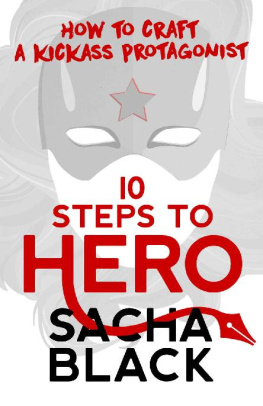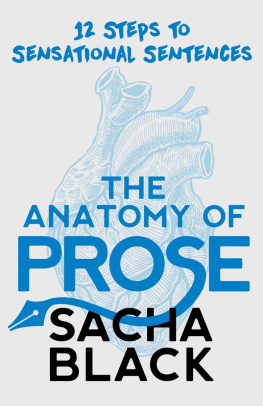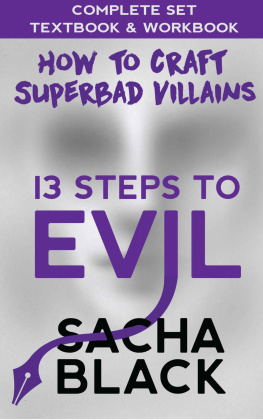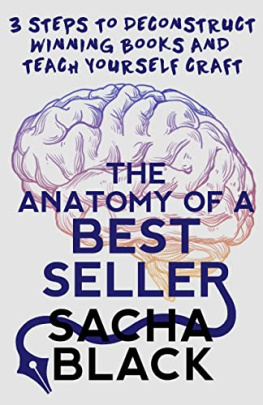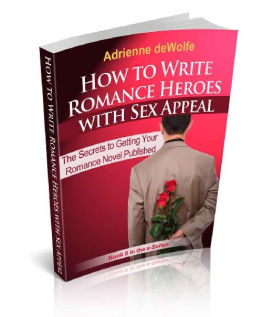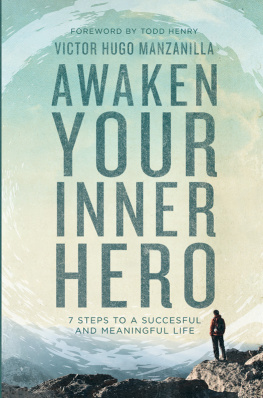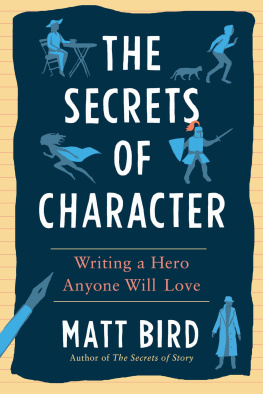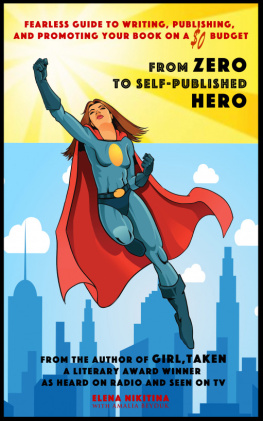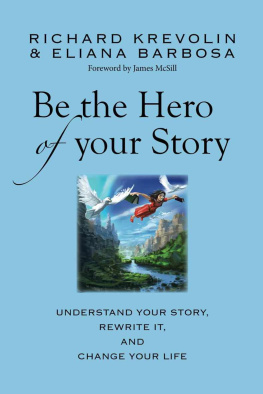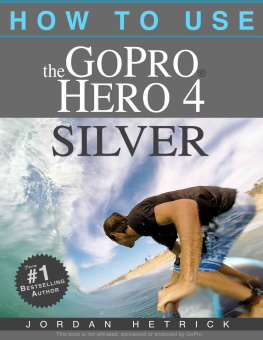10 Steps To Hero
How To Craft A Kickass Protagonist
Sacha Black
10 Steps To Hero How To Craft A Kickass Protagonist
Copyright 2019 Sacha Black
The right of Sacha Black to be identified as the author of this work has been asserted in accordance with the Copyright, Designs and Patents Act 1988.
All rights reserved. No part of this publication may be reproduced, stored in any retrieval system, copied in any form or by any means, electronic, mechanical, photocopying, recording or otherwise transmitted, without permission of the copyright owner. Except for a reviewer who may quote brief passages in a review.
First Published January 2019, by Atlas Black Publishing
Cover design: Andrew Brown, Design for Writers
www.sachablack.co.uk
All rights reserved
Contents
For all the writers who need a little dust on their halo.
Read Me First
I started 13 Steps To Evil - How To Craft A Superbad Villain by saying: heroes are interesting. But mostly theyre predictable. I wrote that book because I wanted to throw a Hiroshima-sized nuke into character creation, up the tension, build the villainous ante and slather stories with enough conflict and nail-biting action readers would rather eat their own kidney than put your books down. And it worked. Thousands of you bought and read 13 Steps To Evil and developed your villains into sinister badasses.
But that also created a problem.
Your villains stole the limelight and your heroes were neglected, left in the dark or maybe I should say light to stare longingly at their glowingly heroic complexions as they decided which princess to save next. Its safe to say that, more often than not, heroes are dull and predictable. But they shouldnt be. And thats why I had to swallow my villainous love and write this book.
Its time to get down and dirty with your protagonist, dust off your star-spangled chivalry pants and prepare for hero beating (into shape, of course; not defeat. This is a book about heroes. And I promise to stop the villain worship in a minute probably).
This book will help you take your heroes from cardboard cut outs to dashing debonairs with glints in their eyes, dusty haloes and killer character arcs. Together, were going to make sure the hero-charm doesnt flatten your story. We dont want heroes with sagging muscles like a has-been Olympic star, thank you very much. Instead, your hero will swoon his way into your readers hearts and grip them page after page after page. Sound like the kind of awesome story with kickass characters youre after? Then I can help.
If youre reading this, my guess is you fit into one of the following categories:
- Your hero is flat, boring or not quite cutting it on the charisma scale
- Youre a cape-wearing villain at heart and couldnt possibly write a charismatic, handsome hero
- You already wrote a hero, but they were clichd and sporting an ego bigger than your word count
- You just want to write better characters
A few points to note about reading this book:
Ive (where possible) avoided any duplication of content from 13 Steps To Evil. Where you will inevitably see repetition is in the definition of a word or term. After all, things can only mean what they mean, and heroes and villains are essentially both book characters. Therefore, there is some minor overlap.
I have used the words hero and protagonist interchangeably throughout this book to avoid repetitive word use. However, they do mean slightly different things in literary terms, and Ill explain the difference in STEP 1 - Define the Debonair. For clarity use whichever word fits your character and your story.
Ive used a wide range of well-known books and films as examples throughout this book. Ive stuck to well-known ones to minimize spoilers. But, inevitably, to illustrate an example fully Ive had to explain some plots. You can avoid all spoilers by skipping over the examples.
But dont skip them. Theyre helpful, obviously.
If youre faint of heart, dislike bad words or dark humor, be aware you might experience some botty tingling throughout the duration of this book. Its not terminal; you will make it to the other side. Trust me; Im a villain doctor.
That might be a lie.
Still with me?
Then lets get our hero on.
1
Read Me Second AKA The Rules
N obody likes rules, least of all me. The day after I was told I wasnt dressed corporately enough, I went to work wearing Converse trainers and leggings. Ive stuck with Converse to this day.
Rules were made for breaking.
When it comes to book creation, there are rules and there are rules. Theyre not the same. The issue with a lot of writing craft books is that theyre written as if theyre tablet and testament: you must have such and such a character arc, thou shalt have this plot beat or twist and that shapely archetype.
No.
No, you must not.
Sure, I might throw out some must dos and dare ye nots or be slain by the book police but mostly theyre for lyrical effect. You and me bro, were wading through the same da-fuck-am-I-doing-storyitis.
Its brutal, but its also liberating. Im not about to slap handcuffs on you and demand you follow every step in this book. Apply what works, leave what doesnt. Its your story.
But there some things you should follow to save yourself from looking like an overly implanted boob: Grammar. Aka the technical writing elements - the bricks and mortar of storytelling. You wouldnt build a skyscraper without foundations, and you wouldnt create a sentence without a capital letter and a full stop. That said, even the hardest of grammar rules can be broken if you know what youre doing. I dont. So I leave those decisions up to professional editors and proofers.
But what about the bendy, contortionist type rules? The red herring or extra subplot, or perhaps the removal of a sacred trope. I like to think of those as the skyscrapers interior decoration. Sure, to me, a candy-floss-pink bathroom with matching Barbi-colored bath and shower unit might look like a gaudy nightmare vomited from a six-year-olds daydream. But hey, the six-year-old loves it. And thats the point.
Theres a hero for everyone. Dont chase trends. The only person who can write your story is you. If you want to include a clich, be my guest. If you dont fancy adding tension to that chapter, thats fine too. Its your story. Dont force it to fit this skyscraper. Nobody puts baby in the corner, and I dont suggest you shove your story or hero into one either. A reader will see right through the corporate lip service youre paying story structure, and it wont do your novel any good. Think of the steps in this book as tools and suggestions. Use what works. The rest? Chuck them in the fuck-it bin and move on. You got heroes to craft.
2
STEP 1 Define The Debonair
T he word hero is Greek, from a root that means to protect and serve Christopher Vogler, The Writers Journey: Mythic Structure for Writers, p.29.
What is a hero?
I mentioned in the introduction that Id use hero and protagonist interchangeably to save your eyes and stave off monotony. But lets get the terms clear from the outset so you can use the one that fits your story best.
While the majority of novels use the same character for the protagonist as the hero, not all do. Strictly speaking, the difference between the two is as follows:

